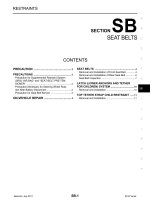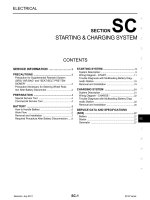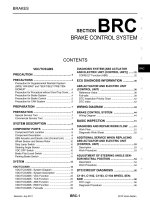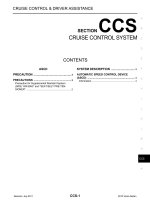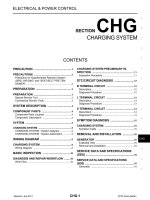SB hệ THỐNG dây ĐAI AN TOÀN TRÊN NISSAN VERSA SEDAN 2012
Bạn đang xem bản rút gọn của tài liệu. Xem và tải ngay bản đầy đủ của tài liệu tại đây (519.29 KB, 10 trang )
SB-1
RESTRAINTS
C
D
E
F
G
I
J
K
L
M
SECTION SB
A
B
SB
N
O
P
CONTENTS
SEAT BELT
PRECAUTION 2
PRECAUTIONS 2
Precaution for Supplemental Restraint System
(SRS) "AIR BAG" and "SEAT BELT PRE-TEN-
SIONER"
2
Precaution for Seat Belt Service 2
BASIC INSPECTION 4
COMPONENT INSPECTION 4
Inspection 4
REMOVAL AND INSTALLATION 6
FRONT SEAT BELT 6
Exploded View 6
SEAT BELT RETRACTOR 6
SEAT BELT RETRACTOR : Removal and Instal-
lation
6
SEAT BELT BUCKLE 7
SEAT BELT BUCKLE : Removal and Installation 7
REAR SEAT BELT 9
Exploded View 9
SEAT BELT RETRACTOR 9
SEAT BELT RETRACTOR : Removal and Instal-
lation
9
SEAT BELT BUCKLE AND TONGUE 10
SEAT BELT BUCKLE AND TONGUE : Removal
and Installation
10
Revision: July 2011 2012 Versa Sedan
SB-2
< PRECAUTION >
PRECAUTIONS
PRECAUTION
PRECAUTIONS
Precaution for Supplemental Restraint System (SRS) "AIR BAG" and "SEAT BELT
PRE-TENSIONER"
INFOID:0000000007652522
The Supplemental Restraint System such as “AIR BAG” and “SEAT BELT PRE-TENSIONER”, used along
with a front seat belt, helps to reduce the risk or severity of injury to the driver and front passenger for certain
types of collision. This system includes seat belt switch inputs and dual stage front air bag modules. The SRS
system uses the seat belt switches to determine the front air bag deployment, and may only deploy one front
air bag, depending on the severity of a collision and whether the front occupants are belted or unbelted.
Information necessary to service the system safely is included in the SR and SB section of this Service Man-
ual.
WARNING:
• To avoid rendering the SRS inoperative, which could increase the risk of personal injury or death in
the event of a collision which would result in air bag inflation, all maintenance must be performed by
an authorized NISSAN/INFINITI dealer.
• Improper maintenance, including incorrect removal and installation of the SRS, can lead to personal
injury caused by unintentional activation of the system. For removal of Spiral Cable and Air Bag
Module, see the SR section.
• Do not use electrical test equipment on any circuit related to the SRS unless instructed to in this
Service Manual. SRS wiring harnesses can be identified by yellow and/or orange harnesses or har-
ness connectors.
PRECAUTIONS WHEN USING POWER TOOLS (AIR OR ELECTRIC) AND HAMMERS
WARNING:
• When working near the Airbag Diagnosis Sensor Unit or other Airbag System sensors with the Igni-
tion ON or engine running, DO NOT use air or electric power tools or strike near the sensor(s) with a
hammer. Heavy vibration could activate the sensor(s) and deploy the air bag(s), possibly causing
serious injury.
• When using air or electric power tools or hammers, always switch the Ignition OFF, disconnect the
battery, and wait at least 3 minutes before performing any service.
Precaution for Seat Belt Service INFOID:0000000007652523
CAUTION:
• Before removing the front seat belt pre-tensioner assembly, turn the ignition switch OFF, disconnect
both battery cables and wait at least three minutes.
• After replacing or reinstalling the front seat belt pre-tensioner assembly, or reconnecting the front
seat belt pre-tensioner connector, check the system function. Refer to SRC-13, "
SRS Operation
Check".
• Do not disassemble buckle or seat belt assembly.
• Do not reuse seat belt anchor bolts after removal. Replace with new ones.
• Replace anchor bolts if they are deformed or worn out.
• Never oil the tongue and buckle.
• If any component of the seat belt assembly is questionable, do not repair. Replace the whole seat
belt assembly.
• If webbing is cut, frayed, or damaged, replace seat belt assembly.
• When replacing seat belt assembly, use a genuine NISSAN seat belt assembly.
AFTER A COLLISION
WARNING:
Inspect all seat belt assemblies including retractors and attaching hardware after any collision.
NISSAN recommends that all seat belt assemblies in use during a collision be replaced unless the col-
lision was minor and the belts show no damage and continue to operate properly. Failure to do so
could result in serious personal injury in an accident. Seat belt assemblies not in use during a colli-
sion should also be replaced if either damage or improper operation is noted. Seat belt pre-tensioners
should be replaced even if the seat belts are not in use during a frontal collision in which the air bags
are deployed.
Replace any seat belt assembly (including anchor bolts) if:
Revision: July 2011 2012 Versa Sedan
PRECAUTIONS
SB-3
< PRECAUTION >
C
D
E
F
G
I
J
K
L
M
A
B
SB
N
O
P
• The seat belt was in use at the time of a collision (except for minor collisions and the belts, retractors and
buckles show no damage and continue to operate properly).
• The seat belt was damaged in an accident. (i.e. torn webbing, bent retractor or guide, etc.)
• The seat belt attaching point was damaged in an accident. Inspect the seat belt attaching area for damage
or distortion and repair as necessary before installing a new seat belt assembly.
• Anchor bolts are deformed or worn out.
• The seat belt pre-tensioners should be replaced even if the seat belts are not in use during a collision in
which the air bags are deployed.
Revision: July 2011 2012 Versa Sedan
SB-4
< BASIC INSPECTION >
COMPONENT INSPECTION
BASIC INSPECTION
COMPONENT INSPECTION
Inspection INFOID:0000000007784192
AFTER A COLLISION
WARNING:
Inspect all seat belt assemblies including retractors and attached hardware after any collision.
NISSAN recommends that all seat belt assemblies in use during a collision be replaced unless the col-
lision was minor and the belts show no damage and continue to operate properly. Failure to do so
could result in serious personal injury in an accident. Seat belt assemblies not in use during a colli-
sion should also be replaced if either damage or improper operation was noted. Seat belt pre-tension-
ers should be replaced even if the seat belts were not in use during a frontal collision in which the air
bags were deployed.
Replace any seat belt assembly (including anchor bolts) if:
• The seat belt is in use at the time of a collision (except for minor collisions and the belts, retractors and buck-
les show no damage and continue to operate properly).
• The seat belt is damaged in an accident (i.e. torn webbing, bent retractor or guide, etc.).
• The seat belt attaching point is damaged in an accident. Inspect the seat belt attaching area for damage or
distortion and repair, if necessary, before installing a new seat belt assembly.
• Anchor bolts are deformed or worn out.
• The seat belt pre-tensioners must be replaced even if the seat belts were not in use during a collision in
which the air bags were deployed.
PRELIMINARY CHECKS
1. Check the seat belt warning lamp for proper operation as per the following:
a. Turn ignition switch ON. The seat belt warning lamp should illuminate.
b. Fasten driver seat belt. The seat belt warning lamp should go out.
2. If the air bag warning lamp is blinking, perform self-diagnosis using CONSULT and air bag warning lamp.
Refer to SRC-13, "
SRS Operation Check".
3. Check that the seat belt retractor, seat belt anchor and buckle bolts are securely attached.
4. Check the shoulder seat belt guide and shoulder belt height adjuster for front seats. Check that guide
swivels freely and that webbing lays flat and does not bind in guide. Check that height adjuster operates
properly and holds securely.
5. Check retractor operation:
a. Fully extend the seat belt webbing and check for twists, tears or other damage.
b. Allow the seat belt to retract. Check that webbing returns smoothly and completely into the retractor. If the
seat belt does not return smoothly, wipe the inside of the loops with a clean paper cloth because dirt build-
up in the loops of the upper anchors can cause the seat belts to retract slowly.
c. Fasten the seat belt. Check that seat belt returns smoothly and completely to the retractor. If the belt does
not return smoothly, the cause may be an accumulation of dust or dirt. Use the “SEAT BELT TAPE SET”
and perform the following steps.
Inspect the front seat belt D-ring anchor
1. Pull the seat belt out to a length of 500 mm (19.69 in) or more.
2. Use a clip or other device to hold the seat belt at the center pillar webbing opening.
3. Pass a thin wire through the D-ring anchor webbing opening. Hold both ends of the wire and pull it
tightly while moving it up and down several times along the webbing opening surface to remove dirt
stuck there.
4. Any dirt that cannot be removed with the wire can be removed by cleaning the opening with a clean
cloth.
5. Apply tape at the point where the webbing contacts the D-ring anchor webbing opening.
NOTE:
Apply the tape so that there is no looseness or wrinkling.
6. Remove the clip holding the seat belt and check that the belt returns smoothly.
6. Repeat steps above, as necessary, to check the other seat belts.
Revision: July 2011 2012 Versa Sedan
COMPONENT INSPECTION
SB-5
< BASIC INSPECTION >
C
D
E
F
G
I
J
K
L
M
A
B
SB
N
O
P
SEAT BELT RETRACTOR ON-VEHICLE CHECK
Emergency Locking Retractors (ELR) and Automatic Locking Retractors (ALR)
NOTE:
All seat belt retractors are of the Emergency Locking Retractors (ELR) type. In an emergency (sudden stop),
the retractor will lock and prevent the webbing from extending any further. All 3-point type seat belt retractors,
except the driver's seat belt, also have an Automatic Locking Retractors (ALR) mode. The ALR mode (also
called child restraint mode) is used when installing child seats. The ALR mode is activated when the seat belt
is fully extended. When the webbing is then retracted partially, the ALR mode automatically locks the seat belt
in a specific position so the webbing cannot be extended any further. To cancel the ALR mode, allow the seat
belt to fully wind back into the retractor.
Check the seat belt retractors using the following test(s) to determine if a retractor assembly is operating prop-
erly.
ELR Function Stationary Check
Grasp the shoulder belt and pull forward quickly. The retractor should lock and prevent the belt from extending
further.
ALR Function Stationary Check
1. Pull out entire length of seat belt from retractor until a click is heard.
2. Retract the belt partially. A clicking noise should be heard as the belt retracts indicating that the retractor is
in the Automatic Locking Retractors (ALR) mode.
3. Grasp the seat belt and try to pull out the retractor. The webbing must lock and not extend any further. If
necessary replace the retractor assembly.
4. Allow the entire length of the webbing to retract to cancel the automatic locking mode.
ELR Function Moving Check
WARNING:
Perform the following test in a safe, open area clear of other vehicles and obstructions (for example, a
large, empty parking lot). Road surface must be paved and dry. DO NOT perform the following test on
wet or gravel roads or on public streets and highways. This could result in an accident and serious
personal injury. The driver and passenger must be prepared to brace themselves in the event the
retractor does not lock.
1. Fasten driver's seat belt. Buckle a passenger into the seat for the belt that is to be tested.
2. Proceed to the designated safe area.
3. Drive the vehicle at approximately 16 km/h (10 MPH). Notify any passengers of a pending sudden stop.
The driver and passenger must be prepared to brace themselves in the event the retractor does not lock.
Apply brakes firmly and make a very hard stop.
During stop, seat belts should lock and not be extended. If the seat belt retractor assembly does not lock, per-
form the retractor off-vehicle check.
SEAT BELT RETRACTOR OFF-VEHICLE CHECK
1. Remove the front seat belt retractor. Refer to SB-6, "SEAT BELT RETRACTOR : Removal and Installa-
tion".
2. Slowly pull out belt while tilting the retractor assembly forward from the mounted position without twisting
the retractor assembly as shown.
• The webbing can be pulled out when the angle (A) is 12
degrees or less.
• The webbing cannot be pulled out when the angle (B) is 27
degrees or more.
- A, B: Tilting angles
- : Vehicle front
3. Replace the seat belt assembly if it does not operate within specifications.
JMHIA1056ZZ
Revision: July 2011 2012 Versa Sedan
SB-6
< REMOVAL AND INSTALLATION >
FRONT SEAT BELT
REMOVAL AND INSTALLATION
FRONT SEAT BELT
Exploded View INFOID:0000000007207721
SEAT BELT RETRACTOR
SEAT BELT RETRACTOR : Removal and Installation INFOID:0000000007207722
REMOVAL
1. Adjuster cover 2. Anchor bolt 3. D-ring anchor
4. Spacer 5. Retaining washer 6. Seat belt adjuster
7. Seat belt pre-tensioner retractor
(Passenger side)
8. Outer anchor 9. Seat belt pre-tensioner retractor
(Driver side)
10. Seat belt buckle 11. Wave washer : Pawl
JMHIA1994GB
Revision: July 2011 2012 Versa Sedan
FRONT SEAT BELT
SB-7
< REMOVAL AND INSTALLATION >
C
D
E
F
G
I
J
K
L
M
A
B
SB
N
O
P
WARNING:
Before servicing, turn ignition switch OFF, disconnect battery negative terminal and wait at least three
minutes.
1. Remove D-ring anchor.
a. Slide front seat to the fully forward position.
b. Pull adjuster cover in direction indicated by arrows as shown.
Remove adjuster cover.
: Pawl
c. Remove D-ring anchor bolt.
2. Remove outer anchor bolt, and then remove outer anchor.
3. Remove seat belt pre-tensioner retractor.
a. Remove front kicking plate and rear kicking plate. Refer to INT-20, "
KICKING PLATE INNER : Removal
and Installation".
b. Remove center pillar lower finisher. Refer to INT-23, "
CENTER PILLAR LOWER GARNISH : Removal
and Installation".
c. Disconnect seat belt pre-tensioner harness connector.
CAUTION:
• For installing/removing seat belt pre-tensioner connector,
insert thin screwdriver wrapped in tape into the notch, lift
locking tab to unlock and then remove the connector.
• Install the pre-tensioner connector with the locking tab
raised, and then push locking tab into the connector to
lock.
d. Remove seat belt pre-tensioner retractor anchor bolt and screw.
4. Remove seat belt adjuster.
a. Remove center pillar upper finisher. Refer to INT-23, "
CENTER PILLAR UPPER GARNISH : Removal and
Installation".
b. Remove seat belt adjuster anchor bolts.
INSTALLATION
Installation is in the reverse order of removal.
SEAT BELT BUCKLE
SEAT BELT BUCKLE : Removal and Installation INFOID:0000000007207724
REMOVAL
1. Remove front seat assembly. Refer to SE-18, "Removal and Installation".
CAUTION:
When removing and installing, use shop cloths to protect parts from damage.
2. Disconnect the seat belt buckle harness connector and release the harness clip(s).
3. Remove seat belt buckle anchor bolt, and then remove seat belt buckle.
JMHIA1639ZZ
PHIA0953J
Revision: July 2011 2012 Versa Sedan
SB-8
< REMOVAL AND INSTALLATION >
FRONT SEAT BELT
INSTALLATION
Installation is in the reverse order of removal.
Revision: July 2011 2012 Versa Sedan
REAR SEAT BELT
SB-9
< REMOVAL AND INSTALLATION >
C
D
E
F
G
I
J
K
L
M
A
B
SB
N
O
P
REAR SEAT BELT
Exploded View INFOID:0000000007207726
SEAT BELT RETRACTOR
SEAT BELT RETRACTOR : Removal and Installation INFOID:0000000007207727
REMOVAL
1. Remove outer anchor.
a. Remove rear seat cushion. Refer to SE-22, "
Removal and Installation - Seat Cushion".
b. Remove outer anchor bolt.
1. Anchor bolt 2. Outer seat belt retractor RH 3. Seat belt finisher
4. Outer anchor 5. Outer seat belt retractor LH 6. RH seat belt buckle
7. Center seat belt buckle 8. Retaining washer 9. Center seat belt retractor
10. LH seat belt buckle Pawl
ALHIA0194GB
Revision: July 2011 2012 Versa Sedan
SB-10
< REMOVAL AND INSTALLATION >
REAR SEAT BELT
2. Remove outer seat belt retractor.
a. Remove seat belt finisher and rear parcel shelf finisher. Refer to INT-24, "
REAR PILLAR FINISHER :
Removal and Installation".
b. Remove seat belt retractor anchor bolt.
INSTALLATION
Installation is in the reverse order of removal.
SEAT BELT BUCKLE AND TONGUE
SEAT BELT BUCKLE AND TONGUE : Removal and Installation INFOID:0000000007207729
REMOVAL
1. Remove rear seat cushion. Refer to SE-22, "Removal and Installation - Seat Cushion".
2. Remove seat belt buckle and tongue anchor bolt, and then remove seat belt buckle and tongue.
INSTALLATION
Installation is in the reverse order of removal.
Revision: July 2011 2012 Versa Sedan
